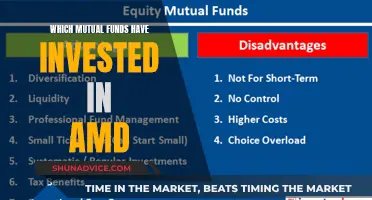
Mutual funds are a great way to maximize your earning potential and prepare for financial security in the future. They are a form of investment that allows you to grow your money through passive income, with a fund manager handling your portfolio and making investment decisions on your behalf. In the Philippines, mutual funds are similar to unit investment trust funds (UITFs) and are an ideal stepping stone for beginners as they don't require a large amount of money to start investing. Some funds only require ₱5,000 as the initial investment. There are different types of mutual funds catering to various investment goals, risk appetites, and instruments where the pooled funds are invested.
| Characteristics | Values |
|---|---|
| Definition | An investment company that pools the funds of many individual and institutional investors to form a massive asset base |
| Example companies | Sun Life, ATRAM, ALFM, Philam, Philequity |
| Investment platforms | COL Financial, FirstMetroSec |
| Types | Stock/equity, balanced, bond, money market, feeder |
| Minimum investment | PHP 1,000-5,000 |
| Subsequent investments | PHP 500 |
| Risk | Low |
| Returns | Moderate |
| Liquidity | High |
| Management | Fund manager |
| Regulator | Securities and Exchange Commission (SEC) |
What You'll Learn

How to choose a mutual fund company
When choosing a mutual fund company, it is important to consider the following factors:
- Regulation and credibility: Ensure that the mutual fund company is regulated by the Securities and Exchange Commission (SEC). This provides credibility and ensures that the company is operating within the legal framework.
- Performance and track record: Research the historical performance of the company's mutual funds. While past performance does not guarantee future results, it can give you an idea of how well the funds have done over time. Look at data such as average returns over 1, 3, 5, and 10-year periods.
- Fees and charges: Mutual fund companies typically charge various fees, such as entry and management fees. Compare the fee structures of different companies and consider how these fees may impact your potential gains. Some companies may offer lower fees, making them a more cost-effective option.
- Investment options: Different mutual fund companies offer various investment options, such as stock/equity funds, bond funds, balanced funds, and money market funds. Choose a company that provides investment options aligned with your financial goals, risk tolerance, and investment style.
- Minimum investment requirements: Some companies have higher minimum investment requirements than others. If you are a beginner investor or have a limited amount of capital, look for companies with lower minimum investment requirements, which can be as low as ₱1,000 to ₱5,000 for the initial investment.
- Convenience and accessibility: Consider the convenience and accessibility of investing with the company. Look for companies that offer online investment platforms or mobile apps, making it easier for you to manage your investments.
- Customer support and resources: Evaluate the level of customer support and resources provided by the company. Choose a company that offers guidance, educational resources, and easy access to fund managers or agents who can answer your questions and provide personalized advice.
Remember, it is essential to do your due diligence and research multiple companies before making a decision. Compare their offerings, reputation, and how well they align with your investment goals and risk tolerance.
A Guide to Investing in Closed-End Funds
You may want to see also

Understanding the different types of mutual funds
There are four basic types of mutual funds in the Philippines: stock/equity funds, balanced funds, bond funds, and money market funds. Each type of fund caters to different investment goals, risk appetites, and instruments where the pooled funds are invested.
Stock/Equity Funds
Stock/equity funds are considered the riskiest type of mutual fund but offer the potential for the biggest returns in the long term (5 years or more). These funds primarily invest in stocks and equities, providing investors with exposure to the stock market. This type of fund is suitable for investors with a higher risk appetite and a longer investment timeframe.
Balanced Funds
Balanced funds, also known as hybrid funds, invest in a mix of stocks, bonds, and other securities. They aim to balance the risk and return potential by diversifying the portfolio. Typically, balanced funds are composed of 60% stocks and 40% bonds. This type of fund is suitable for investors with a low to moderate risk appetite and a moderate investment timeframe of around 3 to 5 years.
Bond Funds
Bond funds, also known as debt funds, invest in bonds and other debt instruments. They are suitable for investors with a low to moderate risk appetite who want to protect their savings against inflation. Bond funds may offer higher profits compared to time deposits and money market investments. This type of fund is ideal for investors seeking a steady income stream and capital preservation.
Money Market Funds
Money market funds are considered the safest type of mutual fund but typically generate lower returns. They invest primarily in short-term, high-quality debt securities such as certificates of deposit, treasuries, and repurchase agreements. Money market funds are suitable for conservative investors with a low-risk appetite and a short-term investment horizon.
Malaysia's Best Mutual Funds: Where to Invest?
You may want to see also

The pros and cons of mutual funds
Mutual funds are a popular investment vehicle in the Philippines, especially for beginners, as they are a beginner-friendly way to generate passive income. They are also a good way to diversify your portfolio and save for the long term.
Advantages of Mutual Funds
- Diversification: Mutual funds allow you to invest in a variety of different types of stocks, bonds, and other securities from numerous industries, reducing investment risk.
- Small investment amounts: Depending on the fund's rules, you may be able to make smaller contributions that can grow over time.
- Professional money management: Mutual funds are professionally managed, and investors benefit from the full-time service of a fund manager who makes investment strategies and decisions to maximise gains and minimise risks.
- Liquidity: Shares can be redeemed on any business day, providing liquidity.
- Low minimum investment: In the Philippines, some mutual funds only require an initial investment of ₱1,000 to ₱5,000, with subsequent investments starting at ₱500.
- Convenience and fair pricing: Mutual funds are easy to buy and understand, typically have low minimum investments, and are traded once per day, eliminating price fluctuations throughout the day.
Disadvantages of Mutual Funds
- Fees and charges: Mutual funds often come with various fees and charges, including management fees, load fees, operating expense ratios, and 12b-1 fees. These can eat into your gains, especially if the fund has a high expense ratio.
- Less control over your portfolio: When investing in mutual funds, you pass on all control to a professional fund manager who makes all investment decisions.
- Potential risks and losses: Returns are not guaranteed, and you may experience losses. While mutual funds are generally considered low-risk, certain types, such as equity funds, are better suited for investors with a higher risk appetite.
- Tax inefficiency: Dividends and interest payments are generally considered taxable income, even if you reinvest the money.
- Poor trade execution: Mutual funds provide a weak execution strategy for investors looking for faster execution times due to short investment horizons or day trading.
The Rich Avoid Index Funds: Why?
You may want to see also

How to set up a mutual fund account
Setting up a mutual fund account in the Philippines is a relatively simple process. Here is a step-by-step guide on how to do it:
Step 1: Evaluate Your Goals and Risk Profile
Before investing in mutual funds, it is important to analyse your financial goals, risk appetite, and how much money you are willing to invest. This will help you determine whether mutual funds are the right investment vehicle for you.
Step 2: Choose a Reputable Mutual Fund Company
Research and select a mutual fund company that is regulated by the Securities and Exchange Commission (SEC). Some popular options in the Philippines include Sun Life, COL Financial, and FirstMetroSec. You can also visit the Philippine Investment Funds Association (PIFA) website to find the best company based on its Net Asset Value Per Share (NAVPS) performance.
Step 3: Consult with an Agent
Once you have chosen a company, you will typically be assigned an agent who can answer your questions and guide you through the process. They will help you select the best type of mutual fund for your needs, considering your financial goals, risk tolerance, and investment timeframe.
Step 4: Gather the Required Documents
The specific requirements may vary depending on the company and your personal circumstances, but generally, you will need to fill out an Investor Profile Questionnaire, a personal information sheet, and submit valid IDs. You may also need to provide proof of address and other supporting documents.
Step 5: Submit the Requirements and Make Your Initial Investment
Submit the completed forms and documents to the mutual fund company, either by visiting their office or sending them via courier. Once your account is approved and you have received confirmation, you can fund your account with your initial investment. The minimum initial investment requirement is typically around ₱1,000 to ₱5,000, and subsequent investments can start at ₱500.
Step 6: Monitor Your Investment
After setting up your account and making your initial investment, remember to track the performance of your mutual fund. Stay in communication with your fund manager to receive updates and ensure that your investment aligns with your financial goals.
Diversify Your Portfolio: Avoid Single Mutual Fund Investments
You may want to see also

Tips for investing in mutual funds
- Evaluate your goals and risk appetite: Before investing, analyse your financial goals, the amount you are willing to invest, and your risk tolerance. This will help you determine if mutual funds are the right investment vehicle for you.
- Choose a reputable company: Ensure that the mutual fund company you select is regulated by the Securities and Exchange Commission (SEC). Research different companies, compare their offerings, and choose one that aligns with your investment goals and risk appetite.
- Understand the different types of mutual funds: In the Philippines, mutual funds can be categorised into four basic types: stock/equity, balanced, bond, and money market funds. Each type carries different levels of risk and potential returns, so it's important to understand these differences before investing.
- Consider the benefits of mutual funds: Mutual funds offer professional fund management, diversification, and the potential for higher returns compared to traditional savings accounts. They are also easily accessible, with some funds requiring a minimum investment as low as ₱1,000 to ₱5,000.
- Be mindful of fees and charges: Mutual funds typically charge various fees, such as annual fund operating expenses and shareholder fees. These fees can impact your potential gains, especially if the fund underperforms, so be sure to consider them when making your investment decision.
- Don't put all your eggs in one basket: While mutual funds can be a great investment option, it's important to diversify your portfolio. Consider other investment options such as VUL, cryptocurrency, or a Personal Equity Retirement Account (PERA) to build wealth.
- Seek professional advice: If you are unsure or need help, don't hesitate to seek advice from a financial advisor or a professional fund manager. They can guide you in choosing the right investment options that align with your financial goals and risk tolerance.
Will Smith's Investment Fund: A Star's Money Move
You may want to see also
Frequently asked questions
There are four basic types of mutual funds in the Philippines: stock/equity funds, balanced funds, bond funds, and money market funds.
Mutual funds are ideal for those new to investing as they are affordable and easily accessible. They are also professionally managed, meaning you benefit from the expertise of a fund manager who will make investment decisions on your behalf.
Identify your financial goals and risk appetite, and assess the best asset allocation for you. If you are still unsure, seek help from a professional advisor.
For mutual funds, you will typically be charged an annual fund operating expense, as well as shareholder fees. These will be outlined in the fund prospectus.







